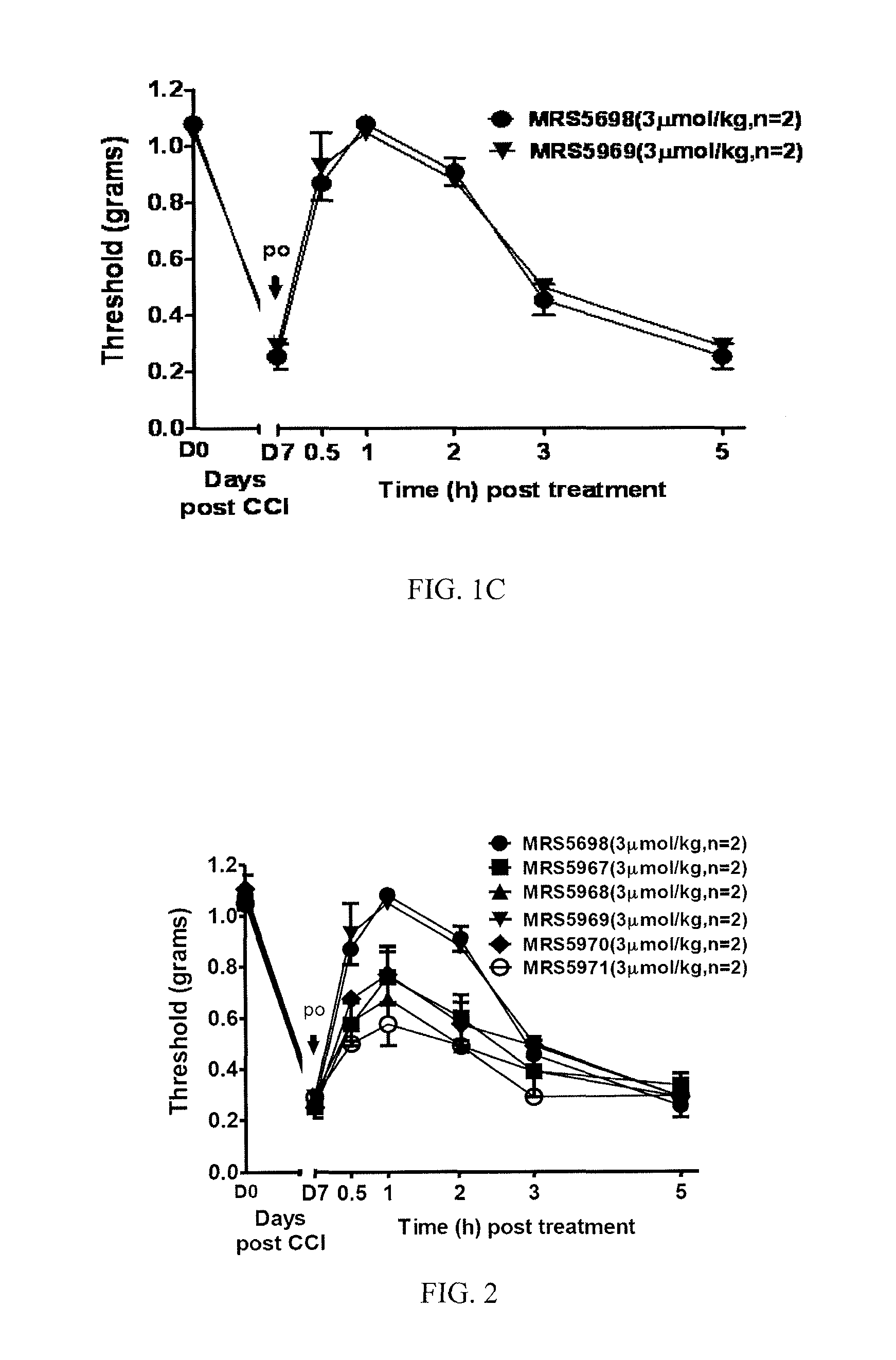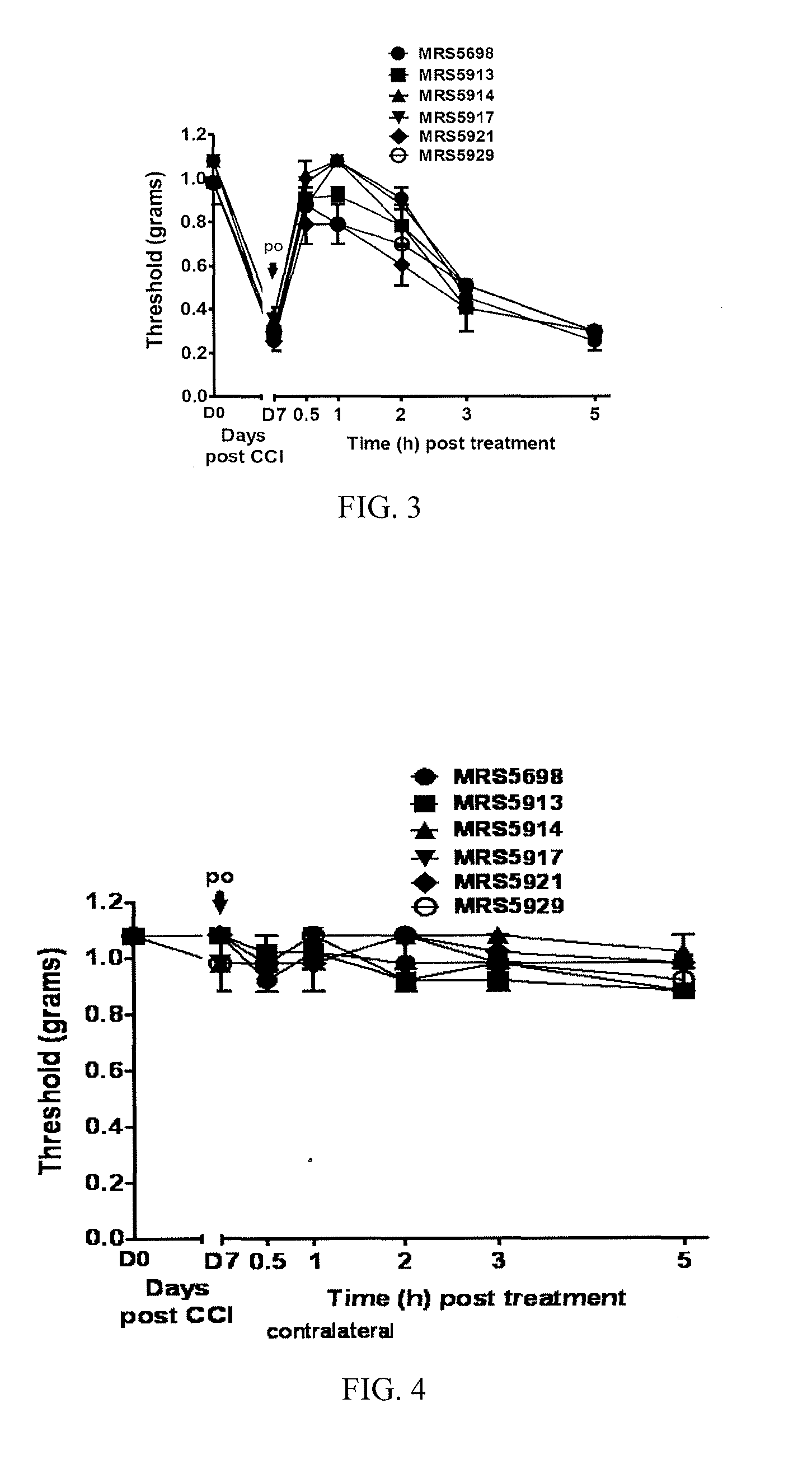A3 adenosine receptor agonists
a technology of adenosine receptor and adenosine, which is applied in the field of a3 adenosine receptor agonists, can solve the problems of poor efficacy and serious side effects of current np therapy, and achieve the effects of preventing neuropathic pain, facilitating blood-brain barrier crossing, and conferring oral bioavailability
- Summary
- Abstract
- Description
- Claims
- Application Information
AI Technical Summary
Benefits of technology
Problems solved by technology
Method used
Image
Examples
example 1
[0155]This example illustrates some of the biological properties of compounds in accordance with an embodiment of the invention.
[0156][3H]R—N6-Phenylisopropyladenosine (40, [3H]R-PIA, 63 Ci / mmol), [3H](2-[p-(2-carboxyethyl)phenyl-ethylamino]-5′-N-ethylcarboxamido-adenosine) (41, [3H]CGS21680, 40.5 Ci / mmol) and [125I]N6-(4-amino-3-iodobenzyl)adenosine-5′-N-methyluronamide (42, [125I]I-AB-MECA, 2200 Ci / mmol) were purchased from PerkinElmer Life and Analytical Science (Boston, Mass.). Test compounds were prepared as 5 mM stock solutions in DMSO and stored frozen. Pharmacological standards 1b (A3AR agonist), adenosine-5′-N-ethylcarboxamide (43, NECA, nonselective AR agonist) and 2-chloro-N6-cyclopentyladenosine (44, CCPA, A1AR agonist) were purchased from Tocris R&D Systems (Minneapolis, Minn.).
[0157]Cell CuIture and Membrane Preparation—
[0158]CHO cells stably expressing the recombinant hA1 and hA3ARs and HEK293 cells stably expressing the hA2AAR were cultured in Dulbecco's modified Eag...
example 2
[0162]This example demonstrates a method of preparing compounds in accordance with an embodiment of the invention.[0163](1S,2R,3S,4R,5S)-2,3-Dihydroxy-N-methyl-4-(6-(methylamino)-2-(pyrimidin-2-ylethynyl)-9H-purin-9-yl)bicyclo[3.1.0]hexane-1-carboxamide (6)
[0164]PdCl2(PPh3)2 (6.08 mg, 0.02 mmol), CuI (1.0 mg, 0.005 mmol), 2-ethynylpyrimidine (27.1 mg, 0.26 mmol) and triethylamine (0.06 mL, 0.43 mmol) were added to a solution of compound 53 (21 mg, 0.04 mmol) in anhydrous DMF (1 mL), and the mixture stirred at room temperature overnight. Solvent was evaporated under vacuum, and the residue was roughly purified on flash silica gel column chromatography. The resulting compound was dissolved in MeOH (2 mL) and 10% trifluoroacetic acid (2 mL) and heated at 70° C. for 5 h. Solvent was evaporated under vacuum, and the residue was purified on flash silica gel column chromatography (CH2Cl2:MeOH=25:1) to give the compound 6 (12.2 mg, 67%) as syrup. 1H NMR (CD3OD, 400 MHz) δ 8.86 (d, J=5.2 Hz,...
example 3
[0286]This example illustrates the performance of compounds in accordance with an embodiment of the invention in an in vivo model of neuropathic pain.
[0287]Experimental Animals.
[0288]Male CD-1 mice (25-30 g) from Harlan (Indianapolis, Ind.) were housed 4-5 (for mice) per cage in a controlled environment (12 h light / dark cycles) with food and water available ad libitum. Experiments were performed in accordance with International Association for the Study of Pain, NIH guidelines on laboratory animal welfare and Saint Louis University Institutional Animal Care and Use Committee recommendations. Experimenters were blinded to treatment conditions in all experiments.
[0289]CCI Model of Neuropathic Pain.
[0290]CCI to the sciatic nerve of the left hind leg in mice was performed under general anaesthesia using the well characterized Bennett model (Bennett, G. J. et al., Pain 1988, 33, 87-107). Briefly, mice (weighing 25-30 g at the time of surgery) were anesthetized with 3% isoflurane / 100% O2 ...
PUM
 Login to View More
Login to View More Abstract
Description
Claims
Application Information
 Login to View More
Login to View More - R&D
- Intellectual Property
- Life Sciences
- Materials
- Tech Scout
- Unparalleled Data Quality
- Higher Quality Content
- 60% Fewer Hallucinations
Browse by: Latest US Patents, China's latest patents, Technical Efficacy Thesaurus, Application Domain, Technology Topic, Popular Technical Reports.
© 2025 PatSnap. All rights reserved.Legal|Privacy policy|Modern Slavery Act Transparency Statement|Sitemap|About US| Contact US: help@patsnap.com



